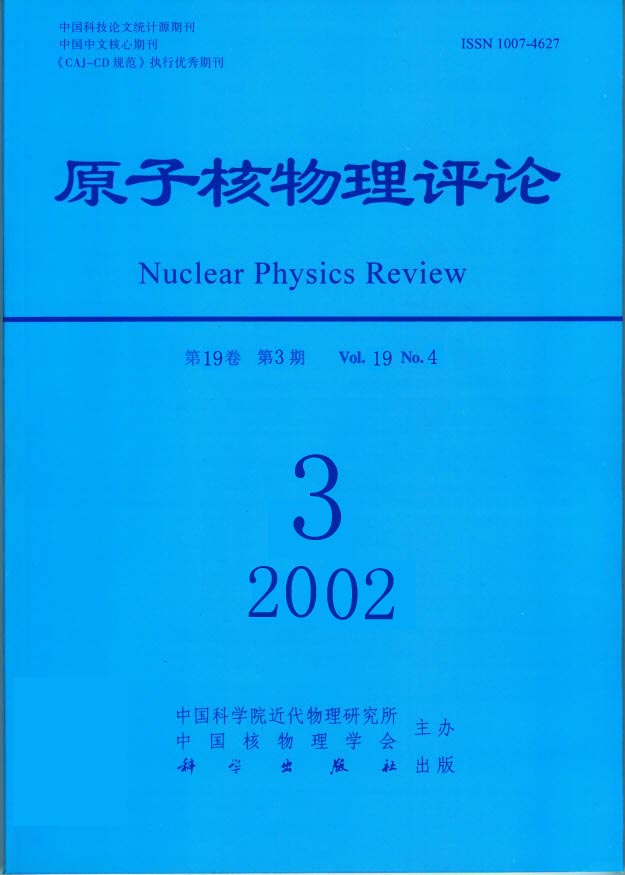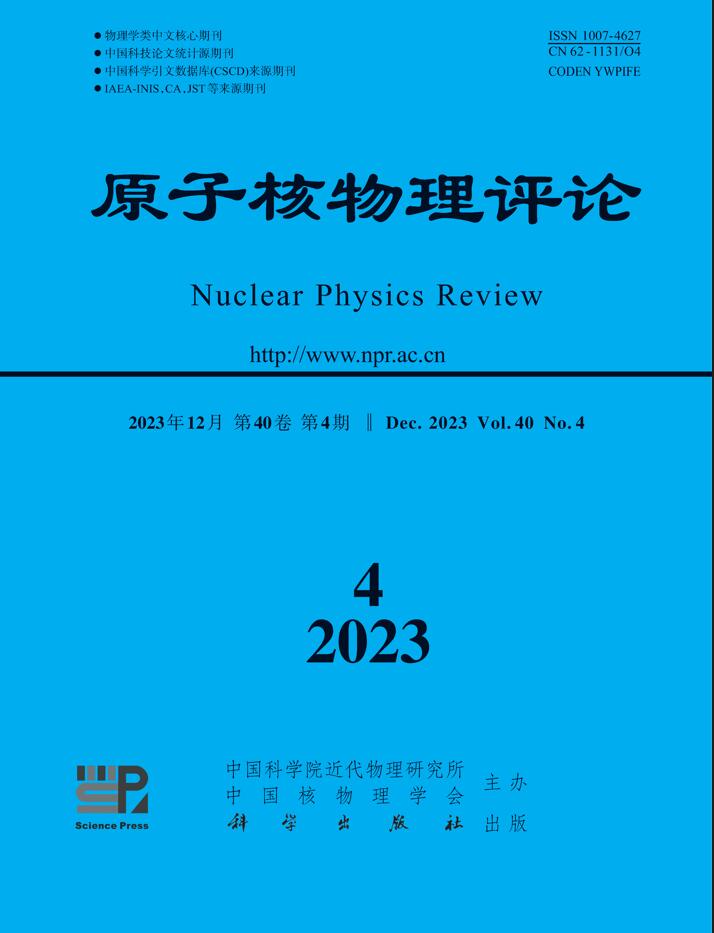2002 Vol. 19, No. 3

Display Method:
2002, 19(3): 301-305.
doi: 10.11804/NuclPhysRev.19.03.301
Abstract:
It is important to measure meson productions in heavy ion collisions in order to understand the dynamics of heavy ion reactions and the properties of nuclear matter. In this paper we review the characteristic and present status of meson productions near the threshold energies in heavy ion collisions. Especially the pion and K + productions are discussed. We point out that it is meaningful and possible to carry out the experimental studies at the CSR. It is necessary to carry out timely the...
It is important to measure meson productions in heavy ion collisions in order to understand the dynamics of heavy ion reactions and the properties of nuclear matter. In this paper we review the characteristic and present status of meson productions near the threshold energies in heavy ion collisions. Especially the pion and K + productions are discussed. We point out that it is meaningful and possible to carry out the experimental studies at the CSR. It is necessary to carry out timely the...
2002, 19(3): 306-315.
doi: 10.11804/NuclPhysRev.19.03.306
Abstract:
The meson physics in heavy ion collisions around energy 1 A GeV is investigated. The experimental data at SIS and Bevalac on medium effects, especially on the signatures of chiral symmetry restoration at finite density are analyzed, and the related problems in the study are pointed out. Finally the possible meson physics at cool storage ring (CSR) is discussed.
The meson physics in heavy ion collisions around energy 1 A GeV is investigated. The experimental data at SIS and Bevalac on medium effects, especially on the signatures of chiral symmetry restoration at finite density are analyzed, and the related problems in the study are pointed out. Finally the possible meson physics at cool storage ring (CSR) is discussed.
2002, 19(3): 316-320.
doi: 10.11804/NuclPhysRev.19.03.316
Abstract:
The mass of the tensor glueball (2 ++ ) is calculated in quantum chromodynamics(QCD) spectral sum rules. The theoretical prediction is in good agreement with the measurements of BES collaboration at BEPC, Beijing and MARK III, which indicates that the mass of the tensor glueball may be around 2.23 GeV.
The mass of the tensor glueball (2 ++ ) is calculated in quantum chromodynamics(QCD) spectral sum rules. The theoretical prediction is in good agreement with the measurements of BES collaboration at BEPC, Beijing and MARK III, which indicates that the mass of the tensor glueball may be around 2.23 GeV.
2002, 19(3): 321-328.
doi: 10.11804/NuclPhysRev.19.03.321
Abstract:
The development of nucleosynthesis theory in Asymptotic Giant Branch (AGB) stars is reviewed. Particularly, the slow neutron capture processes (s processes) and the evolution of AGB stars are briefly described.
The development of nucleosynthesis theory in Asymptotic Giant Branch (AGB) stars is reviewed. Particularly, the slow neutron capture processes (s processes) and the evolution of AGB stars are briefly described.
2002, 19(3): 329-333.
doi: 10.11804/NuclPhysRev.19.03.329
Abstract:
The research for intermediate energy proton accelerator driven radiologically clean nuclear power system has attracted considerable attention. The spallation neutron source induced by intermediate energy proton nucleus interaction is a key point and has not solved yet for the transmutation and applications. The theoretical programs related to the spallation neutron source for accelerator driven system (ADS) are discussed at present work.
The research for intermediate energy proton accelerator driven radiologically clean nuclear power system has attracted considerable attention. The spallation neutron source induced by intermediate energy proton nucleus interaction is a key point and has not solved yet for the transmutation and applications. The theoretical programs related to the spallation neutron source for accelerator driven system (ADS) are discussed at present work.
2002, 19(3): 334-337.
doi: 10.11804/NuclPhysRev.19.03.334
Abstract:
With the introduction of New Buncher 1 system, the article analyzes the influence that these inner components of the NB1 cavity upon it’s working frequency in detail, and according to the physical characteristics of the NB1 cavity, a set of real time control system will be carried out. The NB1 control system includes RF emitter control and moving system control, which both have local control and computer control on RF emitter and five stepping motors.
With the introduction of New Buncher 1 system, the article analyzes the influence that these inner components of the NB1 cavity upon it’s working frequency in detail, and according to the physical characteristics of the NB1 cavity, a set of real time control system will be carried out. The NB1 control system includes RF emitter control and moving system control, which both have local control and computer control on RF emitter and five stepping motors.
2002, 19(3): 338-341.
doi: 10.11804/NuclPhysRev.19.03.338
Abstract:
The emittance compensation technology will be used on the photo cathode RF gun for Shanghai SDUV FEL. In this paper, the space charge force and its effect on electron beam transverse emittance in RF gunis is studied, the principle of emittance compensation in phase space is discussed. We have designed a compensation solenoid and calulated its magnetic field distribution. Its performance has been studied by the code PARMELA. A simulation result indicates that the normalized transverse RMS emi...
The emittance compensation technology will be used on the photo cathode RF gun for Shanghai SDUV FEL. In this paper, the space charge force and its effect on electron beam transverse emittance in RF gunis is studied, the principle of emittance compensation in phase space is discussed. We have designed a compensation solenoid and calulated its magnetic field distribution. Its performance has been studied by the code PARMELA. A simulation result indicates that the normalized transverse RMS emi...
2002, 19(3): 342-346.
doi: 10.11804/NuclPhysRev.19.03.342
Abstract:
The interaction between highly charged ions and surface is investigated, the mechanisms for emissions of electrons, photons and scattered neutral particles, negative and positive ions are reviewed. We report a new atomic physics station in ECR and our work plan.
The interaction between highly charged ions and surface is investigated, the mechanisms for emissions of electrons, photons and scattered neutral particles, negative and positive ions are reviewed. We report a new atomic physics station in ECR and our work plan.
2002, 19(3): 347-351.
doi: 10.11804/NuclPhysRev.19.03.347
Abstract:
The properties of quantum noise and Langevin equation are discussed. Comparisons between the quantum noise and Langevin eqution and the classic one are presented. A brief derivation for quantum Langevin equation is showed. The quantum noise comes from two ways, namely, the way as same as that of classic noise and the Heisenberg uncertainty.
The properties of quantum noise and Langevin equation are discussed. Comparisons between the quantum noise and Langevin eqution and the classic one are presented. A brief derivation for quantum Langevin equation is showed. The quantum noise comes from two ways, namely, the way as same as that of classic noise and the Heisenberg uncertainty.
2002, 19(3): 352-356.
doi: 10.11804/NuclPhysRev.19.03.352
Abstract:
The first order perturbation theory is used to calculate the sensitivity profile of K eff in fast facility. The calculated formulas are given in the sphere co ordinate. As an example, the sensitivity profiles of K eff to ,σ n,f and σ n,γ of GODIVA and ZPR 6/7 are all calculated. The results are also compared with those of FORSS. The calculation results have correct physical meaning and are reliable for application in the actual benchmark review.
The first order perturbation theory is used to calculate the sensitivity profile of K eff in fast facility. The calculated formulas are given in the sphere co ordinate. As an example, the sensitivity profiles of K eff to ,σ n,f and σ n,γ of GODIVA and ZPR 6/7 are all calculated. The results are also compared with those of FORSS. The calculation results have correct physical meaning and are reliable for application in the actual benchmark review.
2002, 19(3): 357-360.
doi: 10.11804/NuclPhysRev.19.03.357
Abstract:
A method used for the calibration of neutron efficiency and the relative photo yield of plastic scintillator is studied. T(p,n) and D(d,n) reactions are used as neutron resources. The neutron efficiencies and the relative photo yields of plastic scintillators 1421 (40 mm in diameter and 5 mm in thickness) are determined in the neutron energy range of 0.655—5 MeV.
A method used for the calibration of neutron efficiency and the relative photo yield of plastic scintillator is studied. T(p,n) and D(d,n) reactions are used as neutron resources. The neutron efficiencies and the relative photo yields of plastic scintillators 1421 (40 mm in diameter and 5 mm in thickness) are determined in the neutron energy range of 0.655—5 MeV.
2002, 19(3): 361-364.
doi: 10.11804/NuclPhysRev.19.03.361
Abstract:
We presente the principle of MOS structure dose detector, reviewe the development and status in this area, and summarise the technique parameters of MOS structure detector, which is widely used in the regions of radiation dose mesurement and space environment monitoring and so on.
We presente the principle of MOS structure dose detector, reviewe the development and status in this area, and summarise the technique parameters of MOS structure detector, which is widely used in the regions of radiation dose mesurement and space environment monitoring and so on.







 甘公网安备 62010202000723号
甘公网安备 62010202000723号